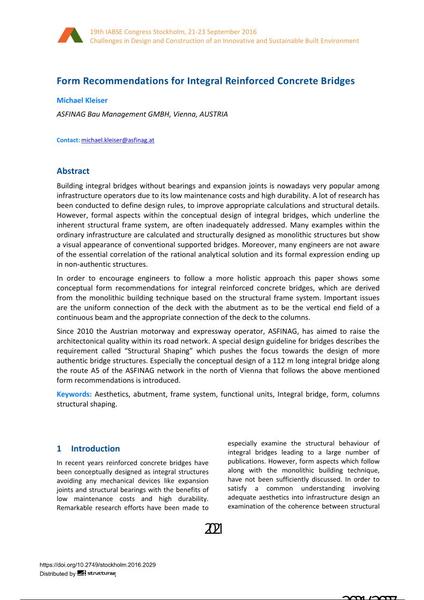Form Recommendations for Integral Reinforced Concrete Bridges

|
|
|||||||||||
Bibliografische Angaben
| Autor(en): |
Michael Kleiser
(ASFINAG Bau Management GMBH, Vienna, AUSTRIA)
|
||||
|---|---|---|---|---|---|
| Medium: | Tagungsbeitrag | ||||
| Sprache(n): | Englisch | ||||
| Tagung: | IABSE Congress: Challenges in Design and Construction of an Innovative and Sustainable Built Environment, Stockholm, Sweden, 21-23 September 2016 | ||||
| Veröffentlicht in: | IABSE Congress Stockholm, 2016 | ||||
|
|||||
| Seite(n): | 2021-2028 | ||||
| Anzahl der Seiten (im PDF): | 8 | ||||
| Jahr: | 2016 | ||||
| DOI: | 10.2749/stockholm.2016.2029 | ||||
| Abstrakt: |
Building integral bridges without bearings and expansion joints is nowadays very popular among infrastructure operators due to its low maintenance costs and high durability. A lot of research has been conducted to define design rules, to improve appropriate calculations and structural details. However, formal aspects within the conceptual design of integral bridges, which underline the inherent structural frame system, are often inadequately addressed. Many examples within the ordinary infrastructure are calculated and structurally designed as monolithic structures but show a visual appearance of conventional supported bridges. Moreover, many engineers are not aware of the essential correlation of the rational analytical solution and its formal expression ending up in non-authentic structures. In order to encourage engineers to follow a more holistic approach this paper shows some conceptual form recommendations for integral reinforced concrete bridges, which are derived from the monolithic building technique based on the structural frame system. Important issues are the uniform connection of the deck with the abutment as to be the vertical end field of a continuous beam and the appropriate connection of the deck to the columns. Since 2010 the Austrian motorway and expressway operator, ASFINAG, has aimed to raise the architectonical quality within its road network. A special design guideline for bridges describes the requirement called “Structural Shaping” which pushes the focus towards the design of more authentic bridge structures. Especially the conceptual design of a 112 m long integral bridge along the route A5 of the ASFINAG network in the north of Vienna that follows the above mentioned form recommendations is introduced. |
||||
| Stichwörter: |
Ästehtik Widerlager Rahmensystem integrale Brücke Form
|
||||


